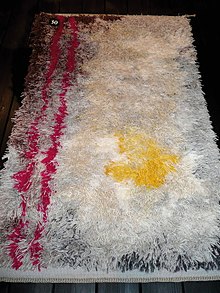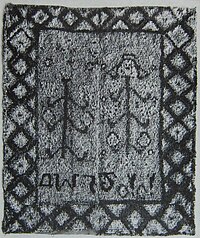Rya (rug)
 Rya | |
| Type | Carpeting |
|---|---|
| Material | Wool |
| Production method | Knotting |
| Production process | Craft production |
| Place of origin | Scandinavia |
| Introduced | 15th century |
Aryaorryeis a traditionalScandinavianwoolrugwith a longpileof about 1 to 3 inches.[1]They are made using a form of theGhiordes knotto make the double-sided pile fabric.[2]Though rya means "rug" inEnglish,the original meaning in Sweden of rya was a bed cover with a knotted pile.[3]The first ryas originated in the early fifteenth century as coarse, long-piled, heavy covers used bymarinersinstead offurs.[4]As time progressed, the rugs have evolved to be lighter and more colorful.[4]Theinsulationthat ryas provide protects against the cold Scandinavian climate.[2][4]Ryas are aknotted pile carpet,with each knot composed of three strands ofwool,which enables the rug to exhibit rich texture from all the different shades of color.[5]The name originates from avillagein southwestSweden.[6]The termryamay also refer to a breed ofsheepwhose wool is used to make rya carpets (seeRya (sheep)).
History
[edit]
In the early 9th to 10th centuries, Islamicsilktextiles were introduced to Scandinavia byVikingmerchants who traded inRussiaand theByzantine Empire.[7]Subsequently, the Scandinavian region acquired knotted pile carpets from theOttomansinAnatolia.[7]In fact, the Marby rug, one of the earliest surviving Turkish carpets was found in the Church of Marby nearJämtland,Sweden.[7]Eventually, Scandinavians themselves produced rugs influenced by theoriental rugdesign.[7]
Ryas inNorwayhave dated back to the early 15th century.[8]During this time, they were worn bysailors,seal hunters,andfishermento protect them from the frigid seas.[4]
Before the rya rug in Sweden,peasantswould sleep between fur skins, but the skins could become stiff and the fur could not be washed.[3]The peasants then used wool plucked directly from the sheep without spinning to simulate fur as close as possible.[3]They used the natural colors of the wool, which wereblack,white,andgrey,to make simple patterns in the high pile.[3]During the weaving, the wool was knotted in.[3]The pile side of the rya had a soft sheen that resembled fur and was placed facing the body just like the fur skins were used previously.[3]The pattern of the flat surface of other side was given less attention, and was the part on which the owner worked in theirinitialsinto the striped geometric design.[3]Later, the wool was put into hot water before being used, which shrunk, stiffened, and tightened the wool.[3]Consequently, the rugs were more durable, but were not as soft and glossy as earlier rya rugs.[3]
At around 1690, a new kind of rya emerged that mimicked foreignBaroquefloral patterns, woven by the daughters and wives of burghers inStockholmand later in thecountry.[3]This new rya had shorter piles and closer rows of knots, which made the rug lighter.[3]Additionally, the pile side now faced up to display the design.[3]Motifs fromcross-stitchsamplerswere incorporated into the rya if foreign Baroque fabric was not available to copy.[3]The new rya concept spread from southern Sweden to northern Sweden.[3]Thus, the rya no longer kept its original practical role and instead became a daytime spread, thus forming the basis of modern-day rya rugs.[3]
InSweden,ryas were used by thenobilityasbeddingas well as a display of social status.[6]However, by the 17th century, they lost their popularity with the nobility, and became bedding for the lower classes.[8]In eighteenth centuryFinland,ryas became decorative, with animal, flower, and symbolic designs.[8]They were used inweddingsasprayer rugs.[8]Rya rugs were part of the bride'sdowry,[9]and the brides were married standing on them.[2]These ryas would be displayed in the home liketapestriesas mementos of the wedding and would often be passed down for generations as family heirlooms.[6]

In the 1970s, rya rugs became popular in theUnited States,though shag carpet was not extensively advertised or promoted by trendsetters.[10]Finnish hand-knotted rya rugs were expensive and considered trendy.[10]Some say that the shag rugs helped keep people warm during times of cold weather during the1973 oil crisiswhen energy was expensive, but the rugs' popularity began before this period.[10]
See also
[edit]References
[edit]- ^Mendelson, Cheryl (1999).Home comforts: the art and science of keeping house.New York, NY: Scribner. p. 479.ISBN0-684-81465-X.
- ^abcMartin, Christina (2005).Weaving: Methods, Patterns, and Traditions of the Oldest Art (Wooden Books).Walker Company. p. 36.ISBN0-8027-1457-9.
- ^abcdefghijklmnoPlath, Iona (1966).The Decorative Arts of Sweden.Dover Publications. pp.9.ISBN0-486-21478-8.
- ^abcd"Classic modern spotlight on Ege Rya".classic-modern.co.uk. 2011.Archivedfrom the original on 23 July 2011.Retrieved5 January2011.
- ^"Ryas Rugs".Retrieved5 January2011.
- ^abc"Scandinavian Antique Rugs and Carpets".NAZMIYAL Inc.Retrieved5 January2011.
- ^abcd"Scandinavian Rugs part 2".NAZMIYAL Inc.Retrieved5 January2011.
- ^abcdSuomi, Paivi (2001)."History of the Rya Rug - All Fiber Arts".Archived fromthe originalon 25 December 2016.Retrieved5 January2011.
- ^"History of Scandinavian Rugs".NAZMIYAL Inc.Retrieved5 January2011.
- ^abcHine, Thomas (2009).The Great Funk: Styles of the Shaggy, Sexy, Shameless 1970s.Farrar, Straus and Giroux. p. 175.ISBN978-0-374-53167-6.
